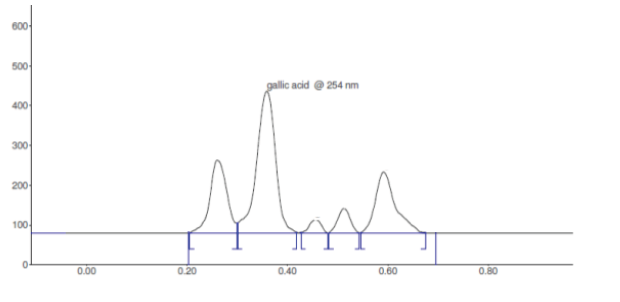


Journal of Pharmaceutical Research
DOI: 10.18579/jopcr/v21i1.ms21.53
Year: 2022, Volume: 21, Issue: 1, Pages: 23-26
Original Article
Runjhun Pallavi ✉ 1, Shivesh Jha 1
1 Department of Pharmaceutical Sciences, Birla Institute of Technology, Ranchi, Jharkhand, Mesra, 835215, India
Corresponding author ✉ : [email protected]
A well-known Ayurvedic formulation, Triphala has numerous health benefits like appetite stimulation, controls diabetes, reduces cholesterol, relieves stress, alleviates inflammation and treats a variety of bacterial and fungal infections along with digestive problems. The phytoconstituents flavonoids, tannins, polyphenols and many chemical compounds are responsible for its claimed health benefits. One of the very significant compounds is gallic acid, which is reported to possess hepatoprotective, anti-inflammatory, antineoplastic and antioxidant properties that are beneficial in treatment of several diseases. In the present work using gallic acid as a marker, an attempt has been made to extract gallic acid from tannins present in Triphala by enzymatic hydrolysis and subsequent estimation of total gallic acid content by high performance thin layer chromatography (HPTLC). Rhizopus oryzae fungus is cultured for the production of enzyme tannase, which converts tannins into gallic acid. The extracted gallic acid is estimated in the biocatalyzed sample at optimal process parameters by high performance thin layer chromatography (HPTLC) method. The gallic acid content after treatment with enzyme was found to be doubled 0.296 ± 0.018 mg/ml, Rf value 0.37 at 254nm which was 0.197 ± 0.008 mg/ml and Rf value was 0.37 prior to enzymatic treatment. Gallic acid in Triphala is present in free form as well as the constituent of tannins. There is a remarkable yield of gallic acid from tannins using the enzyme Tannase in the conversion process. Application of such advanced technology increases the gallic acid yield from response surfaces in herbal and ayurvedic products containing gallic acid. The extraction condition of phenolic compounds can be optimised using enzyme hydrolysis. The effective factors including the solid to solvent ratio, enzyme concentration, particle size and extraction time can be optimised.
Keywords: Triphala, Gallic acid, Tannin, Rhizopus oryzae, Tannase, HPTLC
© 2022 Published by Krupanidhi Educational Trust. This is an open-access article under the CC BY license (https://creativecommons.org/licenses/by/4.0/)
Subscribe now for latest articles and news.